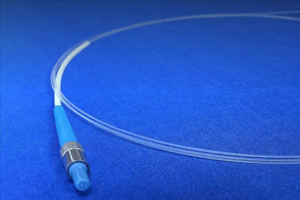The TwinLight™ Concept in Dentistry Reviews
Keywords:medical fiber, surgical fibers, Time:15-12-2015The absence of vibrations, faster healing of soft and bone tissues and relatively pain-free recovery, in addition to bactericidal and biostimulatory effects, make the Er:YAG laser fibers an important surgical instrument. In special situations, such as the treatment of osteonecrosis of the jaws in patients under bisphosphonate therapy, these features become even more important [5]. Treatment success is completed with the LLLT step, provided by the Nd:YAG laser.

LASER-ASSISTED ENDODONTICS
In root canal treatments the laser should be involved in two critical steps needed for successful medical fibers treatment: for cleaning the smear layer in the root canal and for removing bacteria from all parts of the root canal system [6]. Classically, the complete removal of the smear layer is impossible, especially from the side canals. The Er:YAG laser wavelength is used for non-thermal, photoacoustic cleaning and debridement of the complex root-canal system. A saline solution or 17% EDTA and a specially shaped Er:YAG fiber tip are used for the effect of laserinduced photoacoustics. A combination of 6% sodium hypochlorite with an Er:YAG fiber tip effectively eliminates bacteria from the root canal [7,8]. As an alternative to sodium hypochlorite, after the root canal is rinsed and dried, the Nd:YAG laser can be used for deep decontamination. With the TwinLight procedure (Figure 2), an effective success rate for endodontic cases is expected [9].
LASER-ASSISTED PERIODONTICS
Modern periodontal therapy deals with effective removal of infected soft and hard tissue during surgical or non-surgical therapy. There are various benefits of the combined use of laser-assisted and classical methods of periodontal treatments. The Er:YAG laser with an appropriate fiber tip is used for concrement and calculus ablation [10] while removing bacteria [11,12], endotoxins [13] and lipopolysaccharide on the hard root surface, and the elimination of granulomatous tissue on the soft gingival side. The Nd:YAG laser is an indispensable tool to initially decontaminate the pocket [14-17], as well as to deepithelise. Laser-assisted treatment provides successful clinical and microbial results as they are the best solution for decontamination and smear layer removal; eliminating the cause of the periodontal problem and providing a better surface for fibroblast attachment [18]. Both wavelengths help to improve the treatment outcomes [19-23] and patient comfort [21,24-26]. The TwinLight combination of Er:YAG and Nd:YAG laserassisted, minimally invasive periodontal treatment (Figure 3) is able to replace classical invasive surgery or ease the procedure with increased access, selective removal of tissues and biomodulation during the surgical approach.
Many perio-surgical procedures like gingivectomy, gingivoplasty, or operculectomy can be performed by lasers [27] in an elegant way. Very clean cuts of gingival tissue with a desired coagulation depth can be performed with a VSP (Variable Square Pulse Technology) Er:YAG laser without detrimental thermal effects. The surgery can also be combined with the TwinLight Nd:YAG step, if stronger hemostasis is required.
LASER-ASSISTED ORAL IMPLANTOLOGY
In modern implant dentistry there are several clinical indications for laser surgery [28]. Different laser wavelengths are included in practically every step of the implant procedure.
The soft tissues that will surround the implant should be prepared before starting implant surgery. A number of laser wavelengths could be used for this step, but Er:YAG lasers cause less pain as they do not heat the tissue surface as do diode, Nd:YAG or CO2 lasers, and the patient heals faster for the same reason [29].
The removal of granulation tissues and disinfection of the surgical area after extractions is the next important step in implant procedures where Er:YAG lasers have a crucial role (Figure 4). Because of the strong absorption of the Er:YAG laser beam in water, only soft tissue is removed if the parameters are adjusted correctly (energy density and pulse duration).
After the removal of granulation tissues and superficial disinfection [27], the Nd:YAG laser is used for deep disinfection and a biomodulation effect that helps with healing, leading to less edema and pain.
Ablating the bone with Er:YAG [30] laser in order to have the desired coronal bone thickness, such as by removing a knife-edge thin portion to shape a plateau, or an osteotomy for sinus lift, or obtaining a bone block, or bone splitting is advantageous. Also, marking the location of the first drilling site with an Er:YAG laser is easier, especially for new implantologists, because the laser beam cannot slip and cause iatrogenic damage like an implant drill.
Related Articles
- Dentine Hypersensitivity medical Laser fibers Therapy
- Laser Fibers Application in Periodontics
- APPLICATION OF Nd–YAG LASER TREATMENT FOR ORAL LEUKOPLAKIA
- The clinical observation of semi-conductor laser treatment of hypersensitive dentine
- Study on the Influence of Semiconductor Laser Irradiated Time towards Dental Pulp and Dentin
- 980 nm diode lasers in oral and facial practice: current state of the science and art
- Indications and limitations of Er:YAG laser applications in dentistry
- 980 nm diode lasers in oral and facial practice: current state of the science and art
- Global Industry Analysis on Medical Laser Technology Market, 2015 to 2021
- Er:YAG laser applications in dentistry
